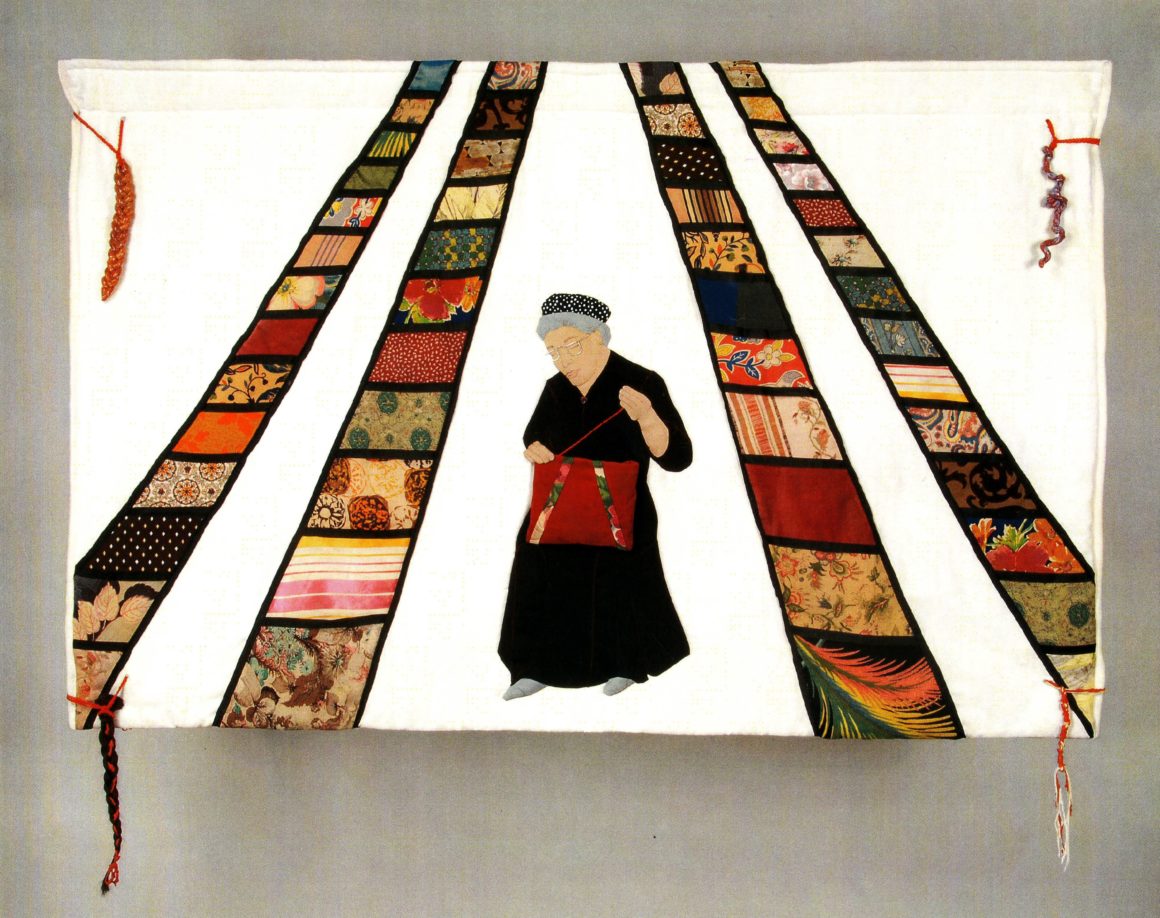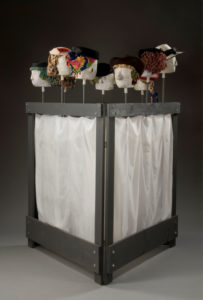
30 Oct Jane Trigère: Women of the Balcony
October 30, 2011 – February 5, 2012
Click here to read the catalogue online
Women of the Balcony honors the women of former Congregation Ohav Sholaum in upper Manhattan. An installation consisting of four fabric wall panels and a three-dimensional sculptural assemblage, it acknowledges the women of the synagogue, many of whom created seat cushions that marked their places in the balcony. The artist has re-fashioned material from those cushions – which she found abandoned in the synagogue after it closed in 2006 – into a narrative that gives meaning to the lives of the mostly anonymous émigré women whose personal histories have been lost.
“My work tries to honor the Jewish women who were the remnants of German Jewry and whose nimble fingers salvaged the remnants of household life . . . curtains, worn-out blouses, out of fashion upholstery. . . and made cushions to mark their places in the shul pews,” Trigere has written. “I heard that these cushions were never moved, even when a woman died; they became markers in death as well.”

Women of the Balcony 4, 2007-2008, mixed media, each panel, 48 x 48 x 48” Supported by a grant from the Hadassah-Brandeis Institute, 2007
In her work, Trigère explores the interdependence of men and women while creating a system of symbols to express their difference. In Women of the Balcony 1, for example, she creates a canvas from a prayer shawl – worn only by men in traditional Orthodox Jewish communities – and integrates it with the fabrics from the cushions that were used by women. The braided ritual fringes attached to the four corners of the garment also are transformed to signify the feminine. At the center of the triangular composition, which also symbolizes the feminine, the artist has placed a self-portrait, a representation of herself as “Everywoman,” with needle in hand. In Women of the Balcony 2 and 3, Trigère treats the intimate upstairs-downstairs nature of the male-female dialogue. And in Women of the Balcony 4, she brings the custom of separating men and women in the synagogue into the literal space of the installation: the women’s heads peek out over the three-sided wood and parachute silk assemblage that represents the balcony divider. The faces are layered with pages from a vernacular prayer book for women; the hair is fashioned out of the leftover scraps of fabric from the cushions, and vintage hats of different periods cover every head.
About the Artist
Congregation Ohav Sholaum was founded in Inwood, in upper Manhattan, in August 1940 in the shadow of the Holocaust. It became a symbol of the annihilation of the European Jewish communities and of their rebirth on American soil. As its membership grew, the congregation relocated from a small hall to larger quarters at 34 Sherman Avenue. It dedicated its own Synagogue building in 1951 at 4624 Broadway and added a Hebrew School in 1957. Ohav Sholaum flourished as a place of worship for the Jewish community of Inwood-Washington Heights under the spiritual leadership of Rabbi Ralph Neuhaus from 1942 until his death in 1990. Rabbi Neuhaus was born in Ostrovo, Germany, which is now part of Poland. He came to the United States with his family in 1941, after being interned by the Belgian and French Governments. He was succeeded by Rabbi Richard Wolpoe, who had served as the synagogue’s cantor from 1987-1990.
Jane Trigère was born in Dobbs Ferry, New York, in 1948. Her work has been included in group exhibitions at Hebrew Union College, in New York City, Philadelphia Museum of Jewish Art, National Yiddish Book Center, in Amherst, MA, and the Vered Gallery in East Hampton, New York, and was featured in a solo exhibition at Yeshiva University Museum in New York in 2007-2008. She has a B.F.A. in Theatre Design from Boston University’s School of Fine Arts and has an M.A. in Jewish Art and Visual Culture from the Jewish Theological Seminary of America in New York. Trigère was a member of Kibbutz Kfar Giladi in northern Israel for six years in the 1980s and now lives in a converted firehouse in South Deerfield, Massachusetts, with her husband, Ken Schoen, a Judaica book dealer.
As a member of the American Association of Museums, The Hebrew Home at Riverdale is committed to publicly exhibiting its art collection throughout its 19-acre campus, including the Derfner Judaica Museum and a sculpture garden overlooking the Hudson River and Palisades. The Derfner Judaica Museum + The Art Collection provide educational and cultural programming for residents of the Hebrew Home, their families and the general public from throughout New York City, its surrounding suburbs and visitors from elsewhere. The Home is a nonprofit, non-sectarian geriatric center serving more than 3,000 elderly persons through its resources and community service programs. Museum hours: Sunday–Thursday, 10:30 a.m.-4:30 p.m. Art Collection open daily, 10:30 a.m.-4:30 p.m.
![]() This exhibition is supported, in part, by public funds from the New York City Department of Cultural Affairs in partnership with the City Council.
This exhibition is supported, in part, by public funds from the New York City Department of Cultural Affairs in partnership with the City Council.

